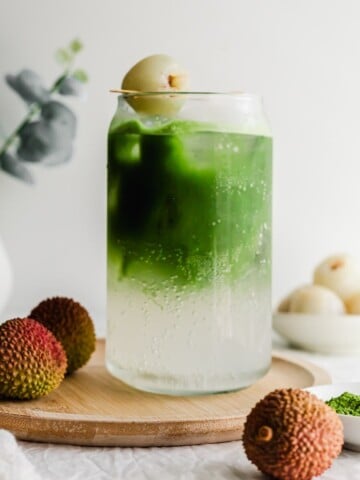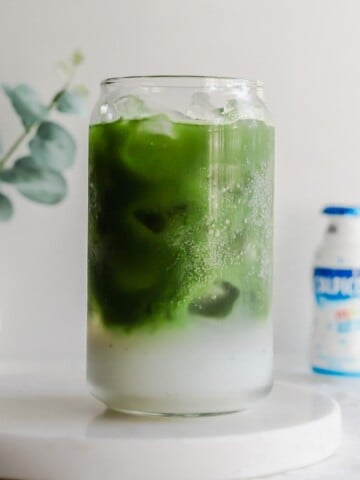This guide shows you how to make a tea espresso using an espresso machine, in a similar manner to brewing espresso coffee.

Want to save this recipe?
Enter your email & I'll send it to your inbox. Plus, get great new recipes from me every week!
What is tea espresso?
Borrowed from the method of making an espresso coffee shot, tea espresso is a method of brewing tea via an espresso machine.
There's no coffee in tea espresso.
(If you're looking for tea and coffee together, try a Matcha Espresso Fusion, also known as a camo latte or dirty latte).
What makes tea espresso different than other tea brewing methods?
Tea espresso yields a concentrated tea flavour in a smaller amount of water, similar to an espresso shot.
Ground/powdered tea vs. loose leaf tea
I found that finely ground tea powder packed in the portafilter did not work in the espresso machine.
The problem is that tea absorbs water, whereas coffee beans do not.
1 shot with loose leaf tea (not ground) yielded quite a bit of water in the extraction, with a flavour similar to steeping it traditionally.
Making the perfect tea espresso
A coarse ground tea (think espresso grounds) gives a chance for the water to penetrate the ground leaves, without it expanding too quickly.
The first shot produces a sweet, smooth tea with crema (similar to coffee).
In coffee terminology, crema is just a thin layer of CO2 bubbles that sit on top of the tea, coming from hot water forced through the the coffee grounds at high pressure.
A second shot releases the bitter tannins that round off the tea flavour.
If you prefer a sweet, tea, use the first shot.
For a rounded, balanced and full tea flavour, use 1 shot, plus an additional shot.
Equipment you'll need
- espresso machine
- portafilter: a metal filter basket with a long handle that attaches to the espresso machine; holds the ground tea
- tamper: presses down on the tea to evenly compact it in the filter
Ingredients you'll need
- loose leaf tea of your choice: coarsely ground (using a coffee grinder); you can use my guide on how to make tea powder
- filtered water
How to make a tea espresso shot
Clean and dry the portafilter.
Add coarsely ground tea to the portafilter and use the tamper to press down lightly.
Attach the portafilter to the espresso machine and lock it into place.
Place a cup underneath the filter.
Pull 1 shot and let the tea drip into the cup.
For a fuller tea flavour, wait a few seconds and pull another 1 shot.

How to serve
Tea espresso is designed to be a concentrated tea shot.
You can enjoy it as is, however, for most people, it's best to add some milk or non-dairy alternative and/or sweetener and turn it into a latte.
Try it as a Jasmine Milk Tea, Hong Kong Milk Tea, Hojicha Latte, or Earl Grey Tea Latte.
FAQs & expert tips
What types of tea can I use?
You can use any tea that you like -- just note that black teas will fare better as they can handle a hotter water temperature.
I've tried it with tea bags as well, and it works. Just empty out the tea from the bags and place into the portafilter.
Can I use hojicha or matcha powder?
No, finely ground tea powder will not work with this method. Water will not be able to flow through the portafilter.
A coarse ground tea powder is OK.
Notes
Optimal water temperature for espresso extraction is around 195F-205F, below boiling point.
While white tea and green teas (such as matcha) should be brewed at a lower temperature (80C/176F), oolong and black teas can handle a higher brewing temperature.
However, I tried it with jasmine tea and I thought it tasted fine.
Depending on your espresso machine, the water temperature should be slightly lower than boiling point, so it doesn't "scorch" the tea.
Changing the coarseness of the tea grounds/powder, can vary the intensity of flavour in the tea. (eg. more coarse = less intense, less coarse = more intense).
For a tea such as loose leaf genmaicha, I found that 1 ½-second blitz was enough. Many pulses yielded a grind that was too fine and absorbed too much water.
*Some caveats*
The oils from coffee can linger in your espresso machine, thereby affecting the taste and flavor of the tea. If you're planning to use the machine for both tea and coffee, be sure to clean the machine thoroughly.
Automatic espresso machines use high pressure, which may not be suitable for the delicate tea leaves. This can result in a bitter taste. If your automatic machine has a hot water function or short extraction at low pressure, try using that.
Tea leaves can clog the machine, especially when they're ground. Use a tea pod (if compatible with your machine) to prevent any loose tea leaves from getting into the machine's internal parts.
Other tea recipes you may like
Be sure to check out these recipes:
Matcha 101: A Beginner's Guide
Hojicha 101: A Beginner's Guide
Let me know if you try out this recipe -- tag me on Instagram @siftandsimmer or leave me a comment/rating below!

How To Make Tea Using An Espresso Machine
For accuracy and precision in baking recipes, use weight (metric) measurements when available.
Ingredients
- 8-9 g loose leaf tea, about 2 tablespoon (black, oolong, earl grey, etc) coarsely ground
- filtered water
Instructions
- Clean and dry the portafilter.
- Add coarsely ground tea to the portafilter and use the tamper to press down lightly.
- Attach the portafilter to the espresso machine and lock it into place.
- Place a cup underneath the filter.
- Pull 1 shot and let the tea drip into the cup.
- For a fuller tea flavour, wait a few seconds and pull an additional shot.
Nutrition
The nutritional information provided should be considered as approximate and is not guaranteed. Please use your best judgment to ensure food is safely prepared and/or a good fit for your diet.







David @ Spiced
Wow - what a fun idea! I've never thought about using our espresso machine to make tea espresso. The problem (at least for us) is ours is automatic (it grinds the beans instead of having a way to add ground beans), so I'm not sure our version will do the job. I'm still intrigued by this idea, though!!
Michelle
Ahhh, I never thought about the automatic espresso machines -- I guess this method would only work if you have a way to remove the portafilter and add in the tea to it. Thanks for sharing, David 🙂
Gary
In the 80’s and 90’s we did this in the coffee shop I worked at. It was super creamy and naturally sweet. Everyone that tried it had their mind blown. We didn’t tell them what it was in advance of tasting it and they loved it but couldn’t figure out what it was. Consider how different brewed coffee and espresso is, this makes the same leap in texture, flavor and aroma.
One warning. We had a technician come service the machine a couple times a month. If we ran too many shots of the tea espresso, he could tell and would get super mad. The difference in resistance would throw off the calibration of the commercial machine so much he say, what the hell are you doing? So it might be wise to use a second hand machine for your tea, and a separate machine for your espresso. This might also be a great reason to the the Flair or some other manual machine since they don’t have any calibration to mess up and costs hundreds not thousands of dollars.
Michelle
Hi Gary, thank you for sharing your experience with us -- great idea to have separate dedicated machines for the tea espresso and coffee espresso. 🙂
Lindsay Wheeler
I'm new to this espresso machine life, but I have an automatic machine that pulls the shot, but I can grind the tea myself and put it in. I have 2 types of filter baskets: double-walled for pressurized pull and single-walled for non-pressurized. Which would you use for tea?
Michelle
Hi Lindsay, thanks for your comment. My espresso machine isn't automatic, and I haven't worked with an automatic machine -- that said, there could be a risk of clogging the machine with the tea leaves if you're not able to manually operate the machine. If you can use the non-pressurized, that would yield a better flavor. Hope that helps.